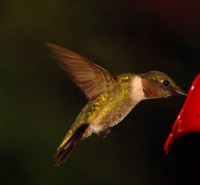Imagine having a special superpower. Go ahead. Close your eyes and imagine yourself flying through the sky, turning your head 280 degrees around, or changing different colors to your surrounding to better camouflage yourself. Every animal, from invertebrates to mammals, have developed specialized and unique characteristics that help to increase the odds of survival.
One amazing insect that has developed a characteristic unlike any other animal calls Pennsylvania its home. I was fortunate enough to discover this moth first hand in early July and have been astonished by what I have found. Many of you may know this interesting “copy-cat”, but most people have not been acquainted to this insect. Do you know what this creature is? If you guessed the Hummingbird Moth, you are correct! The Hummingbird Moth, also known as the “Common Clearwing” (Hemaris thysbe), is a creature like no other. This moth has developed an adaptation throughout its evolutionary process that makes its appearance as that of a hummingbird. Pictured below is first, the Hummingbird Moth, and second a Ruby-Throated Hummingbird. You can see just how similar the mimicking moth looks compared to the bird itself. How amazing!According to the National Audubon Society, Field Guide to Insects and Spiders, “the Hummingbird Moth range stretches from coast to coast in the North and east of the Great Plains south to the Gulf. You can find this unique moth flying in Pennsylvania during the months of May – September along forest edges, meadows, and cultivated flower gardens” (National Audubon Society, Field Guide to Insects and Spiders in North America, P. 778). The flight pattern of a Hummingbird Moth is very similar to that of an actual hummingbird, so try not to be fooled as I was!
Why would a moth want to disguise itself as that of a bird? There must be a reason, but what can it be? Is the reason to intimidate other insects away from a food source? Maybe its visual likeness to the hummingbird is to help ward off predators that eat moths, acting as something the predator would not want? What do you think? Feel free to post a comment if you have any ideas!– Glacier, Summer 2010 Intern
Hummingbird Moth image taken from
www.plantswap.net/forum/f58/bird-moth-5582/
www.locustfork.net/…/index.html



Well, I don’t know, but that thing sure looks cute.
Interesting and also a little creepy. If you find out how the moth evolved, please update this post!
Interesting article!
How unusual is that I have just had an experience of seeing one of these so called moths in Chester the UK (England). This experiancence happened at around 17-40 hrs on the 26th June 2011 whilst in my rear garden. At first I thought it was a hummingbird until I seached on the internet for humming birds and came across the photo on your site BUT WHAT IS IT DOING IN THE UK a long way away from where you are. I await your answer in anticipation. David
I live in the Scottish Borders and this insect or Bird was in my garden today i have taken several pictures of it and couldnt believe how small it is but should it be here at all? comments please
I have just seen one of these moths in my garden in Dublin Ireland….such a tiny little thing. Really looks like a miniature bird!
I saw one of these in my garden yesterday and was amazed, my first thought was that it looked like a hummingbird, i shouted of my husband to come see but sadly he missed it. I knew i had seen something unusual, but came on here to research! It does appear its a long way from home but judging by the comments above maybe not as unusual as i first thought to see one here in britain. I am in the North East of England. I do have a lot of flowers in my garden at present which was obviously the attraction.
We had Hummingbird Moths when we lived in Knoxville, IA about 15 years ago. I remember when I first saw them it was driving me crazy because I’d seen Hummingbirds on our flowers and I knew these little things were not them. They would come in groups of about 3-5 and would get nectar from our beautiful, big patch of Impatiens usually in the late afternoon to early evening hours. I took pictures of them and after asking several people, I discovered what they were. We have since lived in a different area of IA and I haven’t seen them here but we don’t have the Impatiens like at our old house. They are really cute and not as timid as the Hummingbird.
David,I personally don’t know the ranges of Hummingbird Moths well, but some Googling produced this Wikipedia article that notes two species of the Hemaris genus in the UK: http://en.wikipedia.org/wiki/HemarisThere also appears to be a moth of the genus Macroglossum that has a similar appearance to our Hemaris moth. This Wikipedia article shows distribution across Eurasia and Northern Africa: http://en.wikipedia.org/wiki/Macroglossum_stellatarum There are some great pictures of this species at: http://www.leps.it/indexjs.htm?SpeciesPages/MacroStellat.htmBoth genus are mentioned on a UK moths site here: http://ukmoths.org.uk/systematic.php#MacroglossinaeHappy invertebrate watching!~Joshua Potter, Shaver’s Creek Environmental Center
Rather… three Hemaris species in the UK…